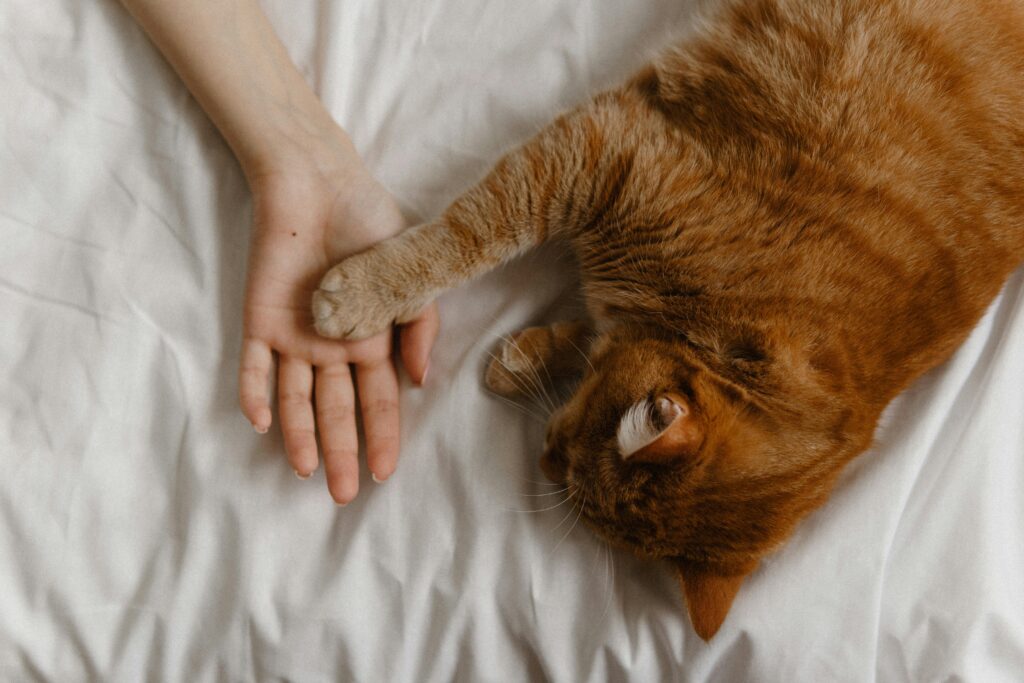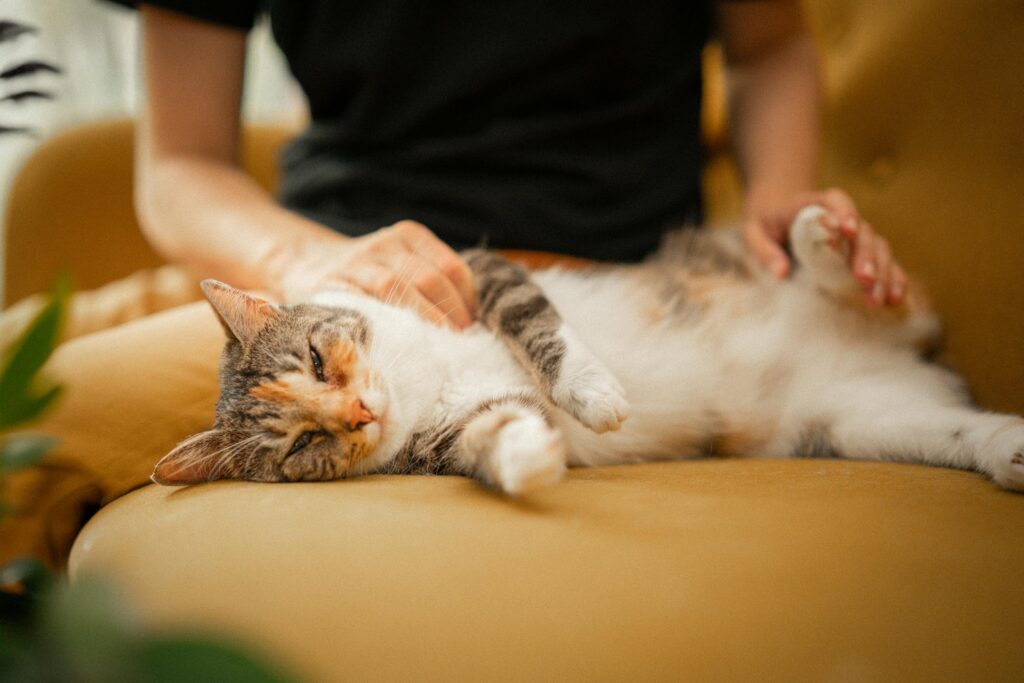Cats are fascinating creatures with behaviours that can sometimes leave us scratching our heads. While they can’t talk, they communicate in their own unique ways. Understanding these behaviours can strengthen the bond between you and your furry friend. Here’s a breakdown of 20 common cat behaviours and what they might really mean.
1. Purring
Cats often purr as an expression of happiness and contentment, signaling that they feel relaxed and secure. However, they can also use purring as a self-soothing mechanism when they are feeling stressed, anxious, or experiencing pain. This versatile behaviour helps them cope with a wide range of emotions and situations, making it an important part of their communication and well-being.
2. Kneading
Frequently referred to as “making biscuits,” kneading is a soothing and instinctive behaviour that originates from a cat’s early days as a kitten. During nursing, kittens knead their mother’s belly to help stimulate the flow of milk, creating a sense of comfort and security that often carries into adulthood.
3. Slow Blinking
A slow blink from your cat is a powerful gesture of trust, love, and affection. When your feline friend looks at you and gradually closes and opens their eyes, they’re essentially saying they feel safe and comfortable in your presence. This tender action, often referred to as a “kitty kiss,” is their way of expressing a deep bond and connection with you.
4. Bringing You “Gifts”
This intriguing behaviour is closely tied to their deeply ingrained hunting instincts. Cats are naturally skilled and instinctive hunters, and when they bring you their prized “catch,” it often serves as a meaningful gesture of affection and inclusion. By offering you their find, they demonstrate that they view you as an important member of their family. It’s their way of sharing their achievements and reinforcing the strong bond they feel with you, while also highlighting their role and contribution within your shared household.
5. Tail Twitching
When a cat’s tail twitches, it can be a strong indicator of their emotional state, often signaling feelings of irritation, excitement, or heightened alertness. Observing the surrounding context and their body language can provide valuable insights into their mood and help you interpret what they’re trying to communicate.
6. Head Bumping
This behaviour, referred to as “bunting,” is your cat’s way of marking you with their scent, essentially claiming you as part of their territory. It’s also a subtle yet meaningful gesture of love and trust, showing their affection and comfort around you.
7. Chirping or Trilling
Cats often chirp or trill as a way of expressing their excitement or to capture your attention. This behaviour is particularly common when they spot something intriguing, such as birds outside the window or other small animals. It’s their unique way of vocalizing interest and engaging with their environment.
8. Hiding
Cats tend to hide when they are experiencing stress, fear, or simply when they want to find a secluded, peaceful spot to unwind and feel secure.
9. Zoomies
Cats often experience sudden bursts of energy, commonly referred to as zoomies, as a natural way to release built-up energy. This behaviour is especially common if they’ve spent the majority of their day lounging or napping, as it helps them stay active and maintain their fitness. These playful, high-energy moments are a reflection of their instinctual need to move and engage in short bursts of activity.
10. Scratching Furniture
Scratching serves multiple purposes for cats, including keeping their claws sharp and healthy while also allowing them to mark their territory visually and through scent. This instinctive behaviour is essential for their well-being. By offering scratching posts or pads, you can help fulfill this natural need while protecting your furniture from damage.
11. Lying on Your Laptop
Cats are naturally attracted to the cozy warmth that your laptop generates, making it an inviting spot for them to rest. Additionally, they might be craving your attention and choosing a place where they know you’re likely to notice them.
12. Exposing Their Belly
When a cat exposes their belly, it’s one of the ultimate signs of trust and comfort. This vulnerable position indicates they feel safe around you. However, it’s important to remember that this gesture doesn’t necessarily mean they’re asking for belly rubs! Many cats prefer that you admire their trust rather than touch their sensitive tummy.
13. Hissing
Hissing is your cat’s way of expressing that they feel threatened, uneasy, or frightened by something in their environment. It’s a clear warning signal that they need space and time to feel safe again. Respect their boundaries and allow them the opportunity to calm down on their own terms.
14. Chattering
Cats often chatter their teeth when they are intently observing potential prey, like birds, squirrels, or other small animals, through a window or from a distance. This curious behaviour is thought to be a combination of feelings, including both excitement at spotting the prey and frustration from being unable to reach it. Some experts also believe it could mimic the killing bite motion they would use in the wild.
15. Ignoring You
Cats are instinctively independent animals, and they tend to interact with those around them only when they feel like it. Their self-reliant nature means they often prefer to set the tone for social interactions. When they are not feeling sociable or are simply in need of some alone time, they might opt to ignore you entirely or retreat to a peaceful, secluded area. Understanding and respecting their boundaries is crucial. Providing them with the autonomy to decide when they’re ready to seek attention, play, or show affection helps build trust and strengthens your bond with them.
16. Licking You
Cats lick as a method of grooming themselves and others, but it’s also a way to create a social connection and strengthen their bond with you. This behaviour is their unique way of expressing affection and making you feel like part of their family.
17. Sitting in Boxes
Cats are naturally drawn to small, enclosed spaces because these cozy spots provide them with a sense of safety, comfort, and security. These areas allow them to feel hidden and protected from potential threats, giving them a peaceful place to relax and observe their surroundings.
18. Staring at You
When a cat stares, it can signify a variety of things, ranging from simple curiosity about their surroundings to a deliberate attempt to capture your attention and communicate with you in their unique feline way.
19. Tail Wrapped Around You
When a cat gently wraps their tail around you, it’s their way of expressing affection, trust, and a deep sense of comfort. This gesture is a subtle yet meaningful sign of their friendship and bond with you, showing that they feel safe and close in your presence.
20. Sleeping on You
Cats choose to sleep on you because they feel a deep sense of trust and security in your presence. They are drawn to the comforting warmth of your body and the familiar scent that makes them feel safe and relaxed.
Understanding your cat’s behaviors can make you a better pet parent and help you build a stronger relationship with your feline friend. Keep observing, and don’t forget to enjoy every quirky moment!

Curious about how cats can be good for your health? Check out our post on Surprising Reasons Owning A Cat Will Improve Your Health
